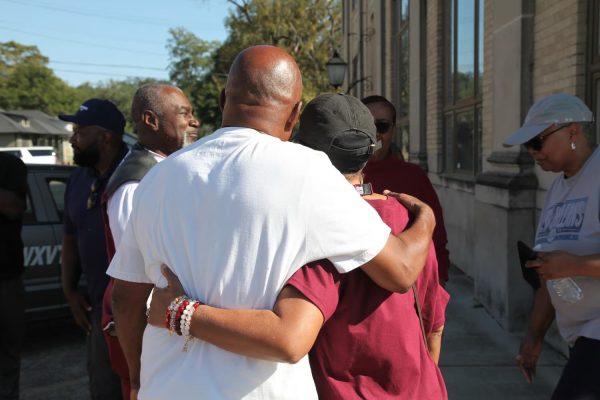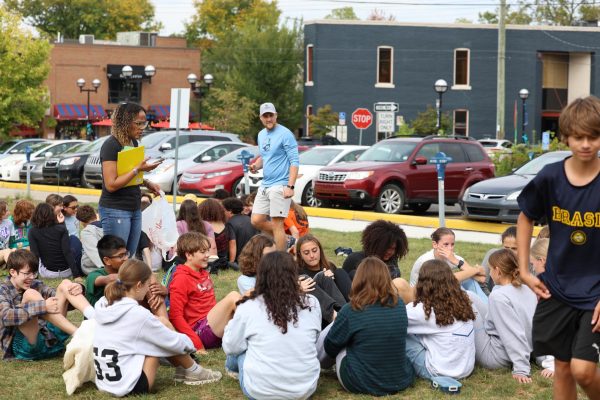History In Bones
University of Michigan Museum of Natural History Opens it’s Bristle Mammoth Exhibit.
On Sept. 30, 2015, on a farm just outside of Chelsea, MI, Jim Bristle and his neighbor found something unexpected when digging a hole for a water pump. They were frantically trying to finish, in order to keep the dirt lining of the walls of the hole from collapsing in on itself. They were each working in backhoes on opposite sides of the hole when they noticed something out of the ordinary. There were bones sticking out of the walls.
Amy Harris, Director of the University of Michigan Museum of Natural History, got the call about the bones the day they were first found, but she wasn’t in that day. Instead, the call got re-routed to the director of the Museum of Paleontology, Daniel Fisher. On Oct. 1, 2015, Dr. Fisher went out to the Bristle’s farm to look at the find. The next day, Dr. Fisher and his team began their one day of excavation.
During the excavation it was discovered that Bristle and his neighbor had discovered mammoth bones believed to have lived 10,000-15,000 years ago.
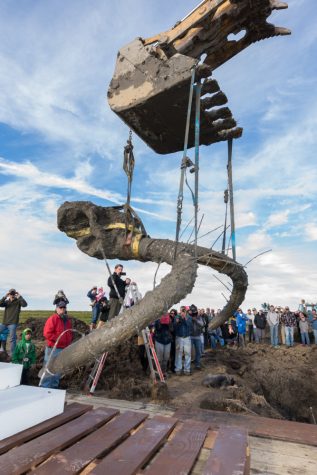
The 150-pound skull and tusks of the Bristle Mammoth being hoisted out of the earth by a crane on a farm outside of Chelsea, MI. University of Michigan staff watch as the skull is lowered onto the back of a truck.
The question of how long ago the mammoth lived is very important and is the reason Dr. Fisher will be going back to excavate at the site again. “He wants to try to get more evidence to support the carbon date for the bones, which was earlier than other mammoth finds in Michigan,” Harris said. “If Dr. Fisher is able to find more evidence for the early date, that would show that humans were here in Michigan earlier than previously thought.”
The University of Michigan has two museums dedicated to prehistoric fossils. The museum open to the public is the Museum of Natural History. The research museum not open to the public is the Museum of Paleontology. The director of the research museum is Dr. Daniel Fisher, who is an expert on Mastodons and Mammoths.
University of Michigan student and Museum intern Allie Scholten, heard about the discovery of the mammoth fossils fairly soon after they were found. Being on campus and being with the museum, Scholten heard of the news almost as soon as they were digging at the field.
“It’s really because of [Dr. Fisher] and his work with the Museum and the University that the exhibit is happening,” Scholten said. “It’s not something that happens everyday.”
Getting the exhibit to be held at the University museum was not very difficult for Harris. “Dr. Fisher came and asked me if I would consider doing it here and I said ‘Yes! We would love to work with you on that,’” Harris said.
Before planning the exhibit, Dr. Fisher wanted to make sure that the public museum was willing to hold the exhibit. Dr. Fisher then talked to Mr. Bristle about whether he would consider donating the fossil finds. Instead of keeping the fossils to himself, Mr. Bristle chose to donate them to the University of Michigan in order to show the public about the new mammoth fossils that had been discovered.
The main focus of the exhibit is the mammoth skull and tusk fossils. This massive skull is on display on a stand supporting most of the weight. It is set up inside a large display case, on one of the walls. There are many descriptive tags explaining why this discovery was so huge. Along with the skull and tusks are a few of the ribs, vertebrae, a section of the jaw, parts of the beast’s pelvis and three boulders found with the bones. These boulders are thought to have been left behind by early humans.
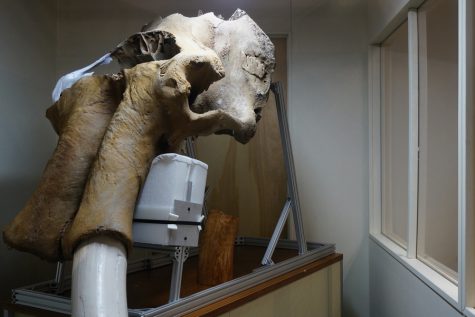
The main focus of the exhibit was the massive Bristle Mammoth skull and tusks. They are on display on the fourth floor of the University of Michigan Museum of Natural History in Ann Arbor, MI.
“The skull has been as it were, sliced open, the way you would cut open a poach egg,” Dr. Fisher said. “You take that top off of it and scoop out what was inside.” He believes that the skull had been cut open, by humans, in order remove the brain. “Why would [a] brain be of interest? Well, there is a lot of nutrition in the brain so brain [can be an] important [nutritional option] for pregnant woman and young children.” According to Dr. Fisher, this is something that ancient humans knew and would go after mammoth in order to harvest this brain tissue.
University of Michigan Neurologist and Sleep Disorders Physician Ron Chervin came to the event with his two teenagers hoping to learn more about what the area surrounding Ann Arbor was like thousands of years ago.
“I think there are a lot of parts from this [dig] that are still missing that they hope they might find and I think it would be really interesting to also get more evidence on what the possible human interaction with this mammoth [was],” Chervin said.
“This particular find is interesting because it has evidence of human involvement,” Harris said. “There are several lines of evidence that it was butchered and stored as meat, kind of [like] a prehistoric refrigerator in a pond and so that’s really interesting.” Dr. Fisher continued to explain how there were other predators around who wanted to eat the carcass of the mammoth as much as the people did. He figured that by storing the meat in a pond they put the meat out of reach of other predators.
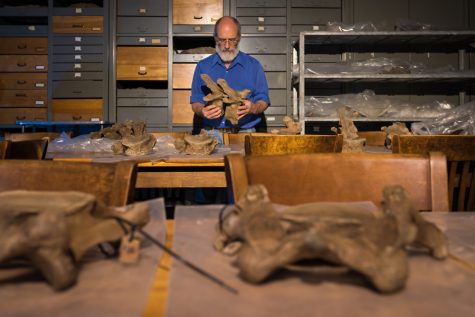
Paleontologist Daniel Fisher works in the classroom in the Museum of Paleontology to identify the mammoth bones.
Dr. Fisher discussed what else was found with the fossils at his lecture on Friday night. “[Mr. Bristle] was digging just behind the skull and there was another thunk,” Dr. Fisher said. “We pulled it up and checked it out. It was a boulder about the size of a medicine ball that weighed 88 and a half pounds. That is a big boulder and it does not belong geologically with the fine grain pond sediments that which the bones were buried.”
Geologically, the site where the bones were found was an ancient pond. There was no stream, so there was nothing that could have brought a boulder that size into the pond other than prehistoric humans.
“We [have] seen boulders like this with other bone sites,” Dr. Fisher said. “[Boulders that couldn’t otherwise be there] are one thing that is associated with human interaction with these animals.”
This particular exhibit and fossil find has gotten people in the Ann Arbor community excited, more than most other temporary exhibits. Harris believes that it is because it was discovered locally.
“It was found just 15 miles away and it’s such a cool animal: a big, huge elephant relative,” Harris said.
“I think that because mammoths and mastodons and elephants in general are so cool, people are naturally curious to learn about them and they care about them,” Harris said. “It’s a really good way to get people interested in science. [The museum] feels like we’re helping to contribute to science literacy and the Mammoth is one piece.”
The Bristle Mammoth exhibit will be on display on the fourth floor of the Museum of Natural History until Jan. 15, 2018. It will then be taken down and will be put in the new location in the Biological Sciences Building, which will open to the public in 2019. As of now, there are no plans to display the mammoth fossils anywhere besides Ann Arbor.




